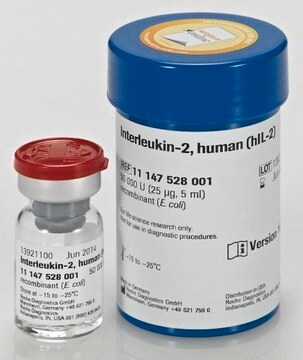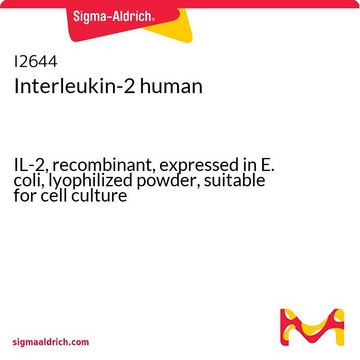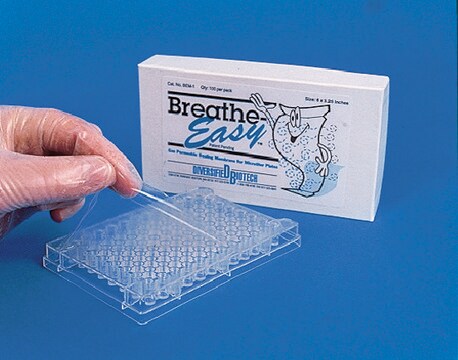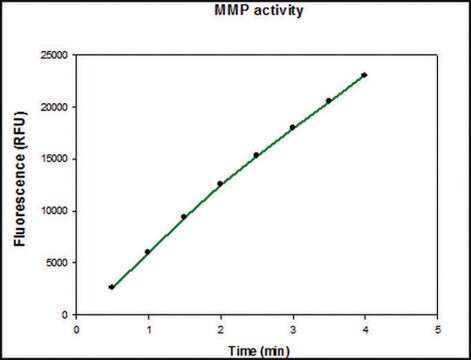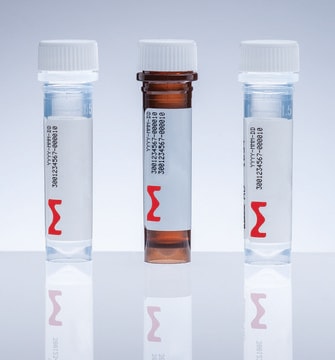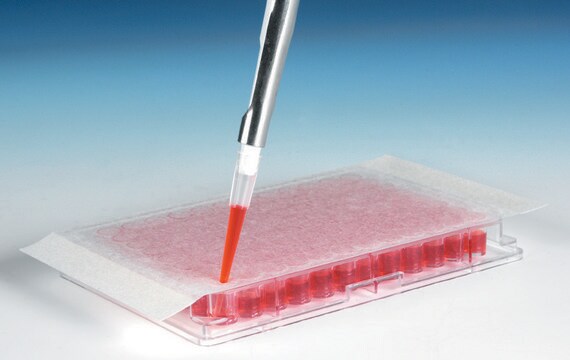推荐产品
生物源
mouse
品質等級
抗體表格
purified antibody
抗體產品種類
primary antibodies
無性繁殖
6-6B, monoclonal
形狀
lyophilized
不包含
preservative
物種活性
human
製造商/商標名
Calbiochem®
儲存條件
OK to freeze
同型
IgG1
運輸包裝
ambient
儲存溫度
2-8°C
目標翻譯後修改
unmodified
基因資訊
human ... MMP9(4318)
一般說明
Matrix metalloproteinases (MMP′s) are a family of enzymes that are responsible for the degradation of extracellular matrix components such as collagen, laminin and proteoglycans. In addition to sequence homology, all MMP′s share the following characteristics: the catalytic mechanism is dependent upon a zinc ion at the active center, they cleave one or more extracellular matrix components, they are secreted as zymogens which are activated by removal of an ~10 kDa segment from the N terminus and they are inhibited by tissue inhibitor of metalloproteinases (TIMP). These enzymes are involved in normal physiological processes such as embryogenesis and tissue remodeling and may play an important role in arthritis, periodontitis, and metastasis.MMP-9 (Gelatinase B, 92 kDa gelatinase/type IV collagenase) is secreted as a 92 kDa zymogen which is proteolytically processed to the 83 kDa active form; a 68 kDa has also been detected. MMP-9, along with its most closely related member of the MMP family, MMP-2, show substrate specificity toward type IV and V collagens, gelatin and elastin. Numerous studies have shown a correlation between collagenase expression and metastatic potential. Elevated levels of MMP-9 in plasma suggest that it may be a useful marker for the diagnosis or prognosis of cancer in general.
Purified mouse monoclonal antibody. Recognizes the ~92 kDa latent and the ~83 kDa active forms of human MMP-9 under non-reducing conditions, but only the latent form under reducing conditions.
Recognizes the ~92 kDa latent and the ~83 kDa active forms of MMP-9 under non-reducing conditions, but only the latent form under reducing conditions. Inhibits the enzymatic activity of MMP-9. For paraffin sections, use Cat. No. IM37L.
This Anti-MMP-9 (Ab-1) Mouse mAb (6-6B) is validated for use in Immunoblotting, Immunoprecipitation, Neutralization Studies, Paraffin Sections for the detection of MMP-9 (Ab-1).
免疫原
Human
MMP-9 from conditioned medium of PMA-stimulated HT-1080 human fibrosarcoma cells
應用
Immunoblotting (2 µg/ml)
Immunoprecipitation (see appplication references)
Neutralization Studies (see comments and application references)
Paraffin Sections (not recommended)
Immunoprecipitation (see appplication references)
Neutralization Studies (see comments and application references)
Paraffin Sections (not recommended)
警告
Toxicity: Standard Handling (A)
外觀
Lyophilized from a volatile buffer, 100 µg BSA.
重構
Store at 4°C until reconstituted, then store in aliquots at -20°C or at 4°C with 0.1% azide. Resuspend the antibody with sterile PBS, pH 7.4, or sterile 20 mM Tris-saline, pH 7.4, to yield a final concentration of 100 µg/ml; product will be more stable if 0.1% sodium azide is included (do not add azide if antibody is to be used with viable cells). Lyophilized antibodies should be resuspended at 4°C with occasional gentle mixing for at least 2 h. Freezing of aliquots is best for long-term storage of reconstituted product; repetitive freezing and thawing should be avoided.
分析報告
Positive Control
MMP-9 protein (Cat. Nos. PF024 or PF038)
MMP-9 protein (Cat. Nos. PF024 or PF038)
其他說明
Cottam, D.W. and Rees, R.C. 1993. Intl. J. of Oncol.2, 861.
Nakajima, M., et al. 1993. Cancer Res.53, 5802.
Ramos-DeSimone, et al. 1993. Hybridoma. 12, 349.
Stetler-Stevenson, W.G., et al. 1993. FASEB.7, 1434.
Zucker, S., et al. 1993. Cancer Res.53, 140.
Woessner, J.F. 1991. FASEB. 5, 2145.
Liotta, L.A. and Stetler-Stevenson, W.G. 1990. in Seminars in Cancer Biology, ed. M.M. Gottesman. Vol. 1; 99-106.
Nakajima, M., et al. 1993. Cancer Res.53, 5802.
Ramos-DeSimone, et al. 1993. Hybridoma. 12, 349.
Stetler-Stevenson, W.G., et al. 1993. FASEB.7, 1434.
Zucker, S., et al. 1993. Cancer Res.53, 140.
Woessner, J.F. 1991. FASEB. 5, 2145.
Liotta, L.A. and Stetler-Stevenson, W.G. 1990. in Seminars in Cancer Biology, ed. M.M. Gottesman. Vol. 1; 99-106.
Inhibits MMP-9 enzymatic activity. For staining paraffin sections, use Anti-MMP-9 (626-644) (Ab-3) Mouse mAb (56-2A4) (Cat. No. IM37L). Antibody should be titrated for optimal results in individual systems.
法律資訊
Not available for sale in Japan.
CALBIOCHEM is a registered trademark of Merck KGaA, Darmstadt, Germany
未找到合适的产品?
试试我们的产品选型工具.
儲存類別代碼
12 - Non Combustible Liquids
水污染物質分類(WGK)
WGK 2
Yao Tong et al.
Journal of inflammation research, 14, 5079-5094 (2021-10-23)
Acute lung injury (ALI) is a severe respiratory disease with high rates of morbidity and mortality. Many mediators regarding endogenous or exogenous are involved in the pathophysiology of ALI. Here, we have uncovered the involvement of integrins and matrix metalloproteinases
Min Hee Park et al.
Stem cells (Dayton, Ohio), 34(8), 2145-2156 (2016-04-20)
Hematopoietic stem/progenitor cell (HSPC) mobilization is an essential homeostatic process regulated by the interaction of cellular and molecular components in bone marrow niches. It has been shown by others that neurotransmitters released from the sympathetic nervous system regulate HSPC egress
Daniel J Price et al.
Cell communication & adhesion, 9(2), 87-102 (2002-12-19)
We studied the invasion of HMT-3522 breast epithelial cells in response to epidermal growth factor (EGF), and the associated signaling pathways. HMT-3522 T4-2 cells were shown to invade Matrigel-coated Transwell membranes in response to EGF while HMT-3522 S-1 cells failed
Andreas Behren et al.
Cancer research, 65(24), 11613-11621 (2005-12-17)
Papillomaviruses are involved in the development of cancers of the female cervix, head and neck, and skin. An excellent model to study papillomavirus-induced tumor induction and progression is the New Zealand White rabbit, where the skin is infected with the
Agnes Schäfer et al.
Frontiers in oncology, 12, 826273-826273 (2022-04-05)
Glioblastoma (GBM) as the most common and aggressive brain tumor is characterized by genetic heterogeneity, invasiveness, radio-/chemoresistance, and occurrence of GBM stem-like cells. The metalloprotease-disintegrin ADAM8 is highly expressed in GBM tumor and immune cells and correlates with poor survival.
我们的科学家团队拥有各种研究领域经验,包括生命科学、材料科学、化学合成、色谱、分析及许多其他领域.
联系技术服务部门